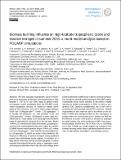| dc.contributor.author | Arnold, S. R. | |
| dc.contributor.author | Emmons, L. K. | |
| dc.contributor.author | Monks, S. A. | |
| dc.contributor.author | Law, K. S. | |
| dc.contributor.author | Turquety, S. | |
| dc.contributor.author | Tilmes, S. | |
| dc.contributor.author | Thomas, J. L. | |
| dc.contributor.author | Bouarar, I. | |
| dc.contributor.author | Flemming, J. | |
| dc.contributor.author | Huijnen, V. | |
| dc.contributor.author | Mao, J. | |
| dc.contributor.author | Duncan, B. N. | |
| dc.contributor.author | Steenrod, S. | |
| dc.contributor.author | Yoshida, Y. | |
| dc.contributor.author | Langner, J. | |
| dc.contributor.author | Long, Y. | |
| dc.contributor.author | Ridley, David Andrew | |
| dc.date.accessioned | 2015-08-19T17:06:51Z | |
| dc.date.available | 2015-08-19T17:06:51Z | |
| dc.date.issued | 2015-06 | |
| dc.date.submitted | 2015-04 | |
| dc.identifier.issn | 1680-7324 | |
| dc.identifier.issn | 1680-7316 | |
| dc.identifier.uri | http://hdl.handle.net/1721.1/98101 | |
| dc.description.abstract | We have evaluated tropospheric ozone enhancement in air dominated by biomass burning emissions at high latitudes (> 50° N) in July 2008, using 10 global chemical transport model simulations from the POLMIP multi-model comparison exercise. In model air masses dominated by fire emissions, ΔO[subscript 3]/ΔCO values ranged between 0.039 and 0.196 ppbv ppbv[superscript −1] (mean: 0.113 ppbv ppbv[superscript −1]) in freshly fire-influenced air, and between 0.140 and 0.261 ppbv ppbv[superscript −1] (mean: 0.193 ppbv) in more aged fire-influenced air. These values are in broad agreement with the range of observational estimates from the literature. Model ΔPAN/ΔCO enhancement ratios show distinct groupings according to the meteorological data used to drive the models. ECMWF-forced models produce larger ΔPAN/ΔCO values (4.47 to 7.00 pptv ppbv[superscript −1]) than GEOS5-forced models (1.87 to 3.28 pptv ppbv[superscript −1]), which we show is likely linked to differences in efficiency of vertical transport during poleward export from mid-latitude source regions. Simulations of a large plume of biomass burning and anthropogenic emissions exported from towards the Arctic using a Lagrangian chemical transport model show that 4-day net ozone change in the plume is sensitive to differences in plume chemical composition and plume vertical position among the POLMIP models. In particular, Arctic ozone evolution in the plume is highly sensitive to initial concentrations of PAN, as well as oxygenated VOCs (acetone, acetaldehyde), due to their role in producing the peroxyacetyl radical PAN precursor. Vertical displacement is also important due to its effects on the stability of PAN, and subsequent effect on NO[subscript x] abundance. In plumes where net ozone production is limited, we find that the lifetime of ozone in the plume is sensitive to hydrogen peroxide loading, due to the production of HO[subscript x] from peroxide photolysis, and the key role of HO[subscript 2] + O[subscript 3] in controlling ozone loss. Overall, our results suggest that emissions from biomass burning lead to large-scale photochemical enhancement in high-latitude tropospheric ozone during summer. | en_US |
| dc.language.iso | en_US | |
| dc.publisher | Copernicus GmbH | en_US |
| dc.relation.isversionof | http://dx.doi.org/10.5194/acp-15-6047-2015 | en_US |
| dc.rights | Creative Commons Attribution | en_US |
| dc.rights.uri | http://creativecommons.org/licenses/by/3.0/ | en_US |
| dc.source | Copernicus Publications | en_US |
| dc.title | Biomass burning influence on high-latitude tropospheric ozone and reactive nitrogen in summer 2008: a multi-model analysis based on POLMIP simulations | en_US |
| dc.type | Article | en_US |
| dc.identifier.citation | Arnold, S. R., L. K. Emmons, S. A. Monks, K. S. Law, D. A. Ridley, S. Turquety, S. Tilmes, et al. “Biomass Burning Influence on High-Latitude Tropospheric Ozone and Reactive Nitrogen in Summer 2008: a Multi-Model Analysis Based on POLMIP Simulations.” Atmos. Chem. Phys. 15, no. 11 (2015): 6047–6068. | en_US |
| dc.contributor.department | Massachusetts Institute of Technology. Department of Civil and Environmental Engineering | en_US |
| dc.contributor.mitauthor | Ridley, David Andrew | en_US |
| dc.relation.journal | Atmospheric Chemistry and Physics | en_US |
| dc.eprint.version | Final published version | en_US |
| dc.type.uri | http://purl.org/eprint/type/JournalArticle | en_US |
| eprint.status | http://purl.org/eprint/status/PeerReviewed | en_US |
| dspace.orderedauthors | Arnold, S. R.; Emmons, L. K.; Monks, S. A.; Law, K. S.; Ridley, D. A.; Turquety, S.; Tilmes, S.; Thomas, J. L.; Bouarar, I.; Flemming, J.; Huijnen, V.; Mao, J.; Duncan, B. N.; Steenrod, S.; Yoshida, Y.; Langner, J.; Long, Y. | en_US |
| dc.identifier.orcid | https://orcid.org/0000-0003-3890-0197 | |
| mit.license | PUBLISHER_CC | en_US |
| mit.metadata.status | Complete | |
